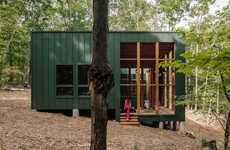Francisco “Patxi†Mangado's solar-powered Spanish Pavilion is an incredibly artistic architectural achievement that also boasts a veritable host of eco-conscious innovations in its design.
Designed and built for the Zaragoza World Expo, the solar-powered Spanish Pavillion was built largely from locally sourced materials. Furthermore, it also houses a state-of-the-art rainwater recycling system and a massive solar panel array on its roof.
Despite its impressive active eco mechanisms, however, it is ironically the solar-powered Spanish Pavilion's passive design features that are the most outwardly obvious. In fact, the entire pavilion is surrounded on all sides by a massive ceramic forest facade that helps keep it cool and shaded even when the suns heat is bearing directly down upon it. Because of this, the structure is currently being prepared to house Spain's National Renewable Energy Center.Photo Credits: designboom, fmangado
Sustainable Ceramic Forests
The Solar-Powered Spanish Pavilion is a Truly Remarkable Structure
Trend Themes
1. Eco-conscious Architecture - The solar-powered Spanish Pavilion showcases innovative architectural designs that incorporate eco-conscious features.
2. Local Sourcing - The use of locally sourced materials in the construction of the Spanish Pavilion presents opportunities for sustainable supply chains.
3. Passive Cooling Systems - The ceramic forest facade of the pavilion demonstrates the potential for passive design features to enhance energy efficiency.
Industry Implications
1. Architecture - Architects can explore eco-conscious designs and passive cooling systems to create sustainable buildings.
2. Construction - The use of locally sourced materials in construction projects promotes sustainable supply chains and reduces environmental impact.
3. Renewable Energy - The solar-powered Spanish Pavilion provides a platform for showcasing and promoting renewable energy technologies.






